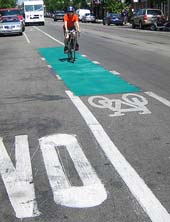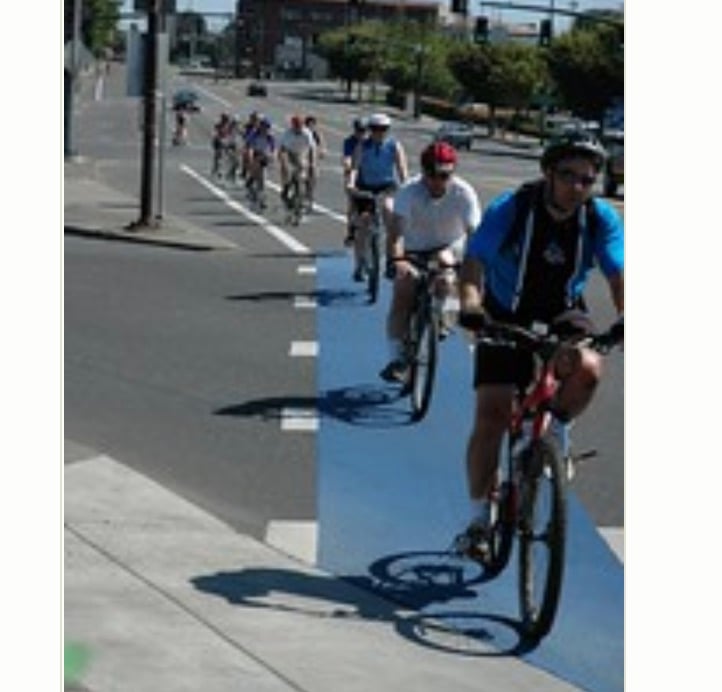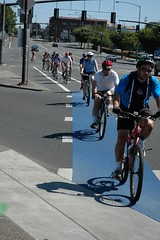Even though funding has now been approved and the political will exists to move forward, the Portland Office of Transportation (PDOT) still has a few wrinkles to iron out before installation begins on colored bike boxes and bike lanes that are slated for 14 dangerous intersections around the city.
PDOT is currently researching two issues: Whether these new intersection treatments should be blue or green; and what exactly is the legal standing of the bike box.
For some context on the issue of color, let’s go back just over ten years ago when Portland first installed their blue bike lanes.
Back in 1997, when PDOT initiated the country’s first experiment in colored bike lanes, they chose blue. A study issued by PDOT shortly after the lanes were installed noted that blue was chosen because of public support, federal restrictions against using red, and evidence from Montreal and Denmark, where blue lanes were already in use.
PDOT’s blue bike lane program was ahead of the curve and did not have official federal sanction (the treatment was so innovative no standards had been set). City traffic engineer Rob Burchfield says they chose blue because it was “a contrasting and visible color that put emphasis on areas of conflict.” While no federal standards existed for colored lanes, PDOT believed the paint itself didn’t have actual meaning as a traffic control device; the white stripes were what technically made it a bike lane.
“If it’s looking like green is the future, we’ll need to convert to that sooner rather than later.”
–City traffic engineer Rob Burchfield
So, with approval from ODOT and a partnership to evaluate the project from a (federally funded) University of North Carolina research team, PDOT became the first city in United States to install blue bike lanes.
However in years since then, Burchfield says revisions in the Manual on Uniform Traffic Control Devices (MUTCD) have declared that blue paint should be used only for handicapped parking areas.
Now, with PDOT ready to go on these new intersection treatments, they face an important choice: What color should they use for these new bike boxes and bike lanes?
Based on what other cities are doing and new discussions taking place by federal traffic control regulators, all signs point to green.
In his initial research, Burchfield found that Burlington Vermont has already gotten federal approval for a green bike lane experiment and that San Francisco has submitted a request as well. In San Francisco, advocates have been pushing for green since their mayor called on that city’s transportation agency to approve them over a year ago.

(Photo from TouringCyclist/Flickr)
Other cities that are going green include Chicago, whose federally sanctioned green bike lane pilot project got started back in June, and New York City, whose green bike lane in Brooklyn graced the front page of this site last July.
In the coming weeks, Burchfield plans to do more research into how green bike lanes are doing in those cities. He says, “If it’s looking like green is the future, we’ll need to convert to that sooner rather than later.”
Another issue that has come up for PDOT is the legal standing of the bike box. Current state law says that bikes must be ridden in the bike lane when it is present under normal conditions (bikes have the right to leave the bike lane for several reasons including hazards or unsafe conditions).
Burchfield and his staff wonder how bike boxes would be interpreted by the courts.
“It’s not a concern of enforcement,” says Burchfield, “but in a civil case, we need to make sure a driver could not make the assertion that a bicyclist [who had moved into the bike box] should be found partially at fault in a collision for not being in the bike lane.”
Since current law limits when a motor vehicle can cross into a bike lane, it doesn’t make sense to simply make bike boxes the legal equivalent of bike lanes. Burchfield see a different way they might approach the question; “Moving into a bike box is essentially being done to avoid a hazard [like a right hook situation] and therefore the existing law might just hold up”.
But Burchfield’s not taking any chances.
“While we don’t think this legal question is big enough to keep us from starting [to install bike boxes], it is something we are looking into and it might result in some proposed updates to the law in our legislative package next session.”


